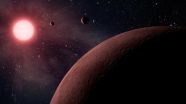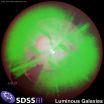(Press-News.org) A new Hubble Space Telescope image centers on the 100-million-solar-mass black hole at the hub of the neighboring spiral galaxy M31, or the Andromeda galaxy, the only galaxy outside the Milky Way visible to the naked eye and the only other giant galaxy in the local group.
This is the sharpest visible-light image ever made of the nucleus of an external galaxy.
The event horizon, the closest region around the black hole where light can still escape, is too small to be seen, but it lies near the middle of a compact cluster of blue stars at the center of the image. The compact cluster of blue stars is surrounded by the larger "double nucleus" of M31, discovered with the Hubble Space Telescope in 1992. The double nucleus is actually an elliptical ring of old reddish stars in orbit around the black hole but more distant than the blue stars. When the stars are at the farthest point in their orbit they move slower, like cars on a crowded freeway. This gives the illusion of a second nucleus.
The blue stars surrounding the black hole are no more than 200 million years old, and therefore must have formed near the black hole in an abrupt burst of star formation. Massive blue stars are so short-lived that they would not have enough time to migrate to the black hole if they were formed elsewhere.
Astronomers are trying to understand how apparently young stars were formed so deep inside the black hole's gravitational grip and how they survive in an extreme environment.
The fact that young stars are also closely bound to the central black hole in our Milky Way galaxy suggests this may be a common phenomenon in spiral galaxies.
Tod R. Lauer of the National Optical Astronomy Observatory in Tucson, Ariz., assembled this image of the nuclear region by taking several blue and ultraviolet light exposures of the nucleus with Hubble's Advanced Camera for Surveys high-resolution channel, each time slightly moving the telescope to change how the camera sampled the region. By combining these pictures, he was able to construct an ultra-sharp view of the galaxy's core.
Lauer is presenting these Hubble observations this week at the meeting of the American Astronomical Society in Austin, Texas.
The image of the Andromeda galaxy was taken on Jan. 13, 2001, with the WIYN/KPNO 0.9-meter Mosaic I by T. Rector, University of Alaska in Anchorage.
INFORMATION:
Hubble zooms in on double nucleus in Andromeda galaxy
2012-01-13
ELSE PRESS RELEASES FROM THIS DATE:
People mimic each other, but we aren't chameleons
2012-01-13
It's easy to pick up on the movements that other people make—scratching your head, crossing your legs. But a new study published in Psychological Science, a journal of the Association for Psychological Science, finds that people only feel the urge to mimic each other when they have the same goal.
It's common for people to pick up on each other's movements. "This is the notion that when you're having a conversation with somebody and you don't care where your hands are, and the other person scratches their head, you scratch your head," says Sasha Ondobaka of the Donders ...
A diet rich in slowly digested carbs reduces markers of inflammation in overweight and obese adults
2012-01-13
SEATTLE – Among overweight and obese adults, a diet rich in slowly digested carbohydrates, such as whole grains, legumes and other high-fiber foods, significantly reduces markers of inflammation associated with chronic disease, according to a new study by Fred Hutchinson Cancer Research Center. Such a "low-glycemic-load" diet, which does not cause blood-glucose levels to spike, also increases a hormone that helps regulate the metabolism of fat and sugar. These findings are published online ahead of the February print issue of the Journal of Nutrition.
The controlled, ...
Astronomers find 3 smallest planets outside solar system
2012-01-13
PASADENA, Calif. -- A team of astronomers led by scientists at the California Institute of Technology (Caltech) has discovered the three smallest confirmed planets ever detected outside our solar system. The three planets, which all orbit a single star, are smaller than Earth and appear to be rocky with a solid surface. Until now, astronomers have found at most only four other rocky planets, also called terrestrial planets, around other stars.
The trio of new planets is too close to the central star to be in its habitable zone—the ring-shaped region around a star where ...
Hubble solves mystery on source of supernova in nearby galaxy
2012-01-13
Using NASA's Hubble Space Telescope, astronomers have solved a longstanding mystery on the type of star, or so-called progenitor, which caused a supernova seen in a nearby galaxy. The finding yields new observational data for pinpointing one of several scenarios that trigger such outbursts.
Based on previous observations from ground-based telescopes, astronomers knew the supernova class, called a Type Ia, created a remnant named SNR 0509-67.5, which lies 170,000 light-years away in the Large Magellanic Cloud galaxy.
Theoretically, this kind of supernova explosion is ...
New information on the waste-disposal units of living cells
2012-01-13
Important new information on one of the most critical protein machines in living cells has been reported by a team of researchers with the U.S. Department of Energy's Lawrence Berkeley National Laboratory (Berkeley Lab) and the University of California (UC) Berkeley. The researchers have provided the most detailed look ever at the "regulatory particle" used by the protein machines known as proteasomes to identify and degrade proteins that have been marked for destruction. The activities controlled by this regulatory particle are critical to the quality control of cellular ...
A clue to the GI problems that plague many kids with autism?
2012-01-13
January 11, 2012 -- New research conducted in the Center for Infection and Immunity (CII) at Columbia University's Mailman School of Public Health, reports that children with autism and gastrointestinal disturbances have high levels of a bacterium called Sutterella in their intestines.
Study findings are published online in the journal mBio.
The investigators found that over half of the children diagnosed with autism and gastrointestinal disturbances had Sutterella in intestinal biopsy tissue, while Sutterella was absent in biopsies from typically developing children ...
Treatment with light benefits Alzheimer's patients, Wayne State University finds
2012-01-13
Detroit - Exposure to light appears to have therapeutic effects on Alzheimer's disease patients, a Wayne State University researcher has found.
In a study published recently in the Western Journal of Nursing Research, LuAnn Nowak Etcher, Ph.D., assistant professor of nursing, reported that patients treated with blue-green light were perceived by their caregivers as having improved global functioning.
Caregivers said patients receiving the treatment seemed more awake and alert, were more verbally competent and showed improved recognition, recollection and motor coordination. ...
Rice's 'quantum critical' theory gets experimental boost
2012-01-13
New evidence this week supports a theory developed five years ago at Rice University to explain the electrical properties of several classes of materials -- including unconventional superconductors -- that have long vexed physicists.
The findings in this week's issue of Nature Materials uphold a theory first offered in 2006 by physicist Qimiao Si, Rice's Harry C. and Olga K. Wiess Professor of Physics and Astronomy. They represent an important step toward the ultimate goal of creating a unified theoretical description of the quantum behavior of high-temperature superconductors ...
ISG15: A novel therapeutic target to slow breast cancer cell motility
2012-01-13
Interferon-stimulated gene 15 (ISG15), a ubiquitin like protein, is highly elevated in a variety of cancers including breast cancer. How the elevated ISG15 pathway contributes to tumorigenic phenotypes remains unclear and is the subject of a study published in the January 2012 issue of Experimental Biology and Medicine. Dr. Shyamal Desai and her co-investigators from the Louisiana State University School of Medicine in New Orleans, the University of Pennsylvania School of Medicine in Philadelphia, and the Robert Wood Johnson School of Medicine in New Jersey report that ...
Calculating what's in the universe from the biggest color 3-D map
2012-01-13
Since 2000, the three Sloan Digital Sky Surveys (SDSS I, II, III) have surveyed well over a quarter of the night sky and produced the biggest color map of the universe in three dimensions ever. Now scientists at the U.S. Department of Energy's Lawrence Berkeley National Laboratory (Berkeley Lab) and their SDSS colleagues, working with DOE's National Energy Research Scientific Computing Center (NERSC) based at Berkeley Lab, have used this visual information for the most accurate calculation yet of how matter clumps together – from a time when the universe was only half its ...




